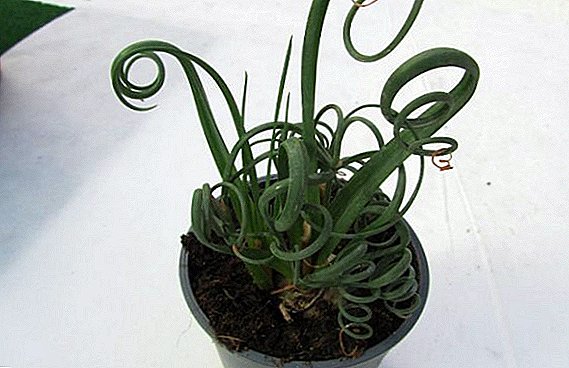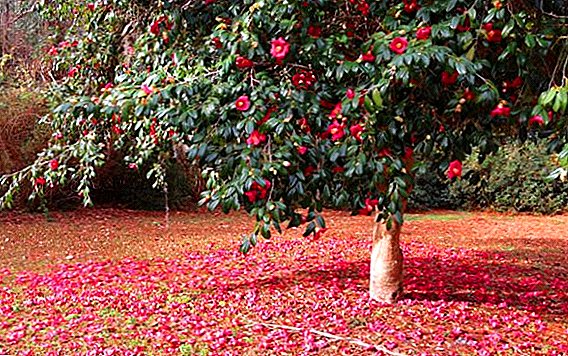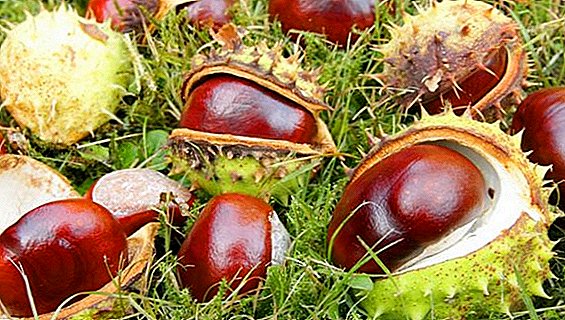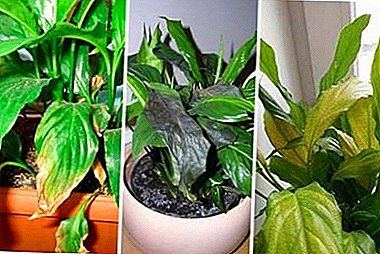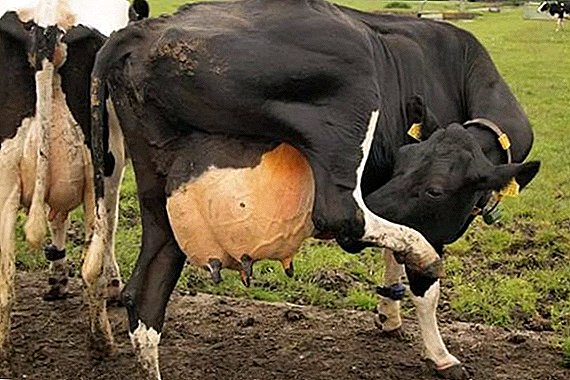 The appearance of a white vaginal discharge in a domestic cow is by no means always a signal of the presence or beginning of any pathological process. Sometimes they can mean the start of estrus, mark a pregnancy, and also signal a calving. Nevertheless, there is a possibility that the appearance of such a symptom is a sign of the development of certain gynecological diseases in your wards. This article is designed to help you better navigate the causes of the discharge of the cow’s discharge and the likely ways to eliminate it.
The appearance of a white vaginal discharge in a domestic cow is by no means always a signal of the presence or beginning of any pathological process. Sometimes they can mean the start of estrus, mark a pregnancy, and also signal a calving. Nevertheless, there is a possibility that the appearance of such a symptom is a sign of the development of certain gynecological diseases in your wards. This article is designed to help you better navigate the causes of the discharge of the cow’s discharge and the likely ways to eliminate it.
White discharge from a cow: why it appears and what to do
Most often, cow excretions have the character of fairly pronounced filamentous fibers that stretch out from the vagina and cling to the legs, tail or hair in other places. In the event that you are sure that the appearance of vaginal discharges is entirely and completely triggered by some normal physiological cause, from the above mentioned, then there is no need to do anything to eliminate them.
It will probably be useful for you to find out how much an average cow weighs and on what its weight depends.
Any physiological phenomenon that falls within the age norm of an animal not only does not harm it, but most likely will bring significant benefits. Most often we are talking about the subsequent birth of a calf or an unscheduled increase in milk production. Sometimes, however, bulls run into a frenzy from the smell and type of vaginal discharge of the cows, but they are often kept separately from the females, so they can not cause them any significant harm.  In the same case, if the appearance of various liquids separated from the genitals of a cow seems to you to be unhealthy, has some unnatural appearance or smell, and she herself is restless and shows all the classic signs of the disease - you need to immediately start to act. Below you will find information about what exactly the selection are in cows, what they mean and how to deal with them.
In the same case, if the appearance of various liquids separated from the genitals of a cow seems to you to be unhealthy, has some unnatural appearance or smell, and she herself is restless and shows all the classic signs of the disease - you need to immediately start to act. Below you will find information about what exactly the selection are in cows, what they mean and how to deal with them.
Transparent vaginal exudates
Transparent fibers resembling saliva in color, slippery to the touch, light, tearing without noticeable effort, sometimes having a specific, but not harsh and not fetid odor, with their general appearance most similar to transparent mucus - these are completely normal products of vaginal secretion of cows. Most often, such secretions appear at the beginning of the estrus process, and this indicates that the cow is healthy, in good physical shape and ready for a new phase of mating.
Important! Do not panic, if closer to the end of the period of estrus, excretions suddenly become cloudy and become more dense - this is the normal physiological response of the animal’s body to the replacement of hormonal levels.Exudates of similar nature are separated from the birth canal of the female a few hours before the onset of labor, but it must be well remembered that immediately after childbirth and the placenta leave the vagina, nothing more should be separated. If the discharge goes, albeit of a transparent nature, then this is a clear sign that the animal develops adnexitis or an inflammatory process of any other parts of the genital organs.
 The treatment in this case is intramuscular or intravenous administration of antibacterial agents, isolation of the sick individual from the herd in a separate room and the organization of careful monitoring of its condition.
The treatment in this case is intramuscular or intravenous administration of antibacterial agents, isolation of the sick individual from the herd in a separate room and the organization of careful monitoring of its condition.Important! By itself, colorless mucus does not pose any threat to the health of the animal and very rarely can be a symptom of any pathology.In case of deterioration of the overall picture, it is recommended to call a veterinarian for help. The most extreme and least pleasant way to develop a situation in case of inflammation of the internal genital organs is the appearance of the need to remove the latter.
It is also possible the appearance of secrets of a similar nature in the first two months of pregnancy. Their feature is also the location right along the middle line of the cow's body and the special, sticky, cord-like appearance of these secretions. A similar phenomenon is observed in almost all pregnant cows, but its absence does not mean that the cow is sick.
White discharge from the vulva and udder
A liquid or mucus that has a whitish hue, but for all other parameters no different from serous exudates, is most likely caused by the same reasons that were described in the previous section of the article.
Find out what to do if a cow has udder swelling.
The reason for a change in the physiological color of the secret may be a change in the hormonal background of the animal, its gradual aging or a change in the chemical composition of the secretions due to metabolic changes, etc.  Mucous-purulent exudate in cows The appearance of such secretions is possible even if, as a result of intercourse, a bull provoked the development of an infectious disease in a female. Most often we are talking about vaginitis, which in case of inadequate treatment can go into the colpitis, and then into salpingitis and adnexitis. You can understand that your cow is ill with a similar disease, by the complex of symptoms consisting of the presence of the secretions described above and the general intoxication syndrome (fever, restless behavior of the animal, refusal to eat and drink, excessive aggression towards fellows, etc.) ). In this case, the diseased individual must be isolated, treated with antibacterial drugs and monitor the state of health of the animal.
Mucous-purulent exudate in cows The appearance of such secretions is possible even if, as a result of intercourse, a bull provoked the development of an infectious disease in a female. Most often we are talking about vaginitis, which in case of inadequate treatment can go into the colpitis, and then into salpingitis and adnexitis. You can understand that your cow is ill with a similar disease, by the complex of symptoms consisting of the presence of the secretions described above and the general intoxication syndrome (fever, restless behavior of the animal, refusal to eat and drink, excessive aggression towards fellows, etc.) ). In this case, the diseased individual must be isolated, treated with antibacterial drugs and monitor the state of health of the animal.
The dangerous diseases of cows also include mastitis, leukemia, foot and mouth disease.
The separation of such a secret is also possible if, as a result of previous pathological processes due to inflammation, the uterine muscle layer, the endometrium, was drawn in a chronic manner. In such a female, mucus often begins to stand out a few days after calving, its amount increases over time, and the color gradually changes from whitish to brown and then to reddish. Endometriosis is one of the most likely causes of cervical cancer and other large processes in the vagina and uterus.therefore it is best to seek help from a veterinarian.
Video: Treatment and prevention options for endometritis in cows
It is also possible the separation of white, viscous, rather oily, semi-liquid substance from the udder during pregnancy, and sometimes in the period preceding mating. This fluid has the name "colostrum", and the reason for its appearance is that in the female's body there is an active restructuring of all hormonal systems for future breeding of offspring, which require more fat and viscous milk than usual cows give every day. Isolation of colostrum can be called a kind of rehearsal before feeding future calves. Sometimes it can occur up to several times during a single pregnancy. This process does not require treatment.
Important! The isolation of substances of any other nature from the udder is isolated phenomena that are not even properly described in the literature. If you notice udder excretions that differ from those described, it will be best to call the vet.
Purulent whites in cows
The appearance of yellowish (from yellow to dark brown) discharge, heterogeneous, with an unpleasant odor, viscous, viscous, with a large number of veins of different colors - this is a clear sign of the addition of a bacterial infection in addition to inflammation of any of the urogenital system or in as an independent disease. Often this nature of the discharge indicates that the cow has chronic endometritis.
The only adequate therapy for such conditions is a constant 2-3 times (per day) washing of the reproductive organs of the cow with any disinfecting solutions, for example, a 3% solution of alum with the addition of 1% pioctannin concentration.  When a purulent vaginal discharge appears in a cow, first of all try to determine for sure which inflammation of which part of the urogenital system it is connected with. So you can save time and money on the treatment of cows that have defeated all or almost all parts of the sexual apparatus. These animals, with a very high degree of probability, although they will remain alive as a result of treatment, will never be able to give birth to calves, and their milk yield will inevitably decrease every year.
When a purulent vaginal discharge appears in a cow, first of all try to determine for sure which inflammation of which part of the urogenital system it is connected with. So you can save time and money on the treatment of cows that have defeated all or almost all parts of the sexual apparatus. These animals, with a very high degree of probability, although they will remain alive as a result of treatment, will never be able to give birth to calves, and their milk yield will inevitably decrease every year.
Learn how to identify and treat hoof disease in cows.
Prevention of gynecological diseases
Prevention of gynecological diseases in cows should be primarily based on the observance of all hygienic standards in the premises of the farm where animals are kept, in places where matings take place, and also in the corral for livestock grazing.  The more specific measures of prevention include the following:
The more specific measures of prevention include the following:
- Do not allow contact of sick cows with healthy ones;
- prevent a variety of occupational injuries in the livestock;
- it is necessary to try to replace the process of natural fertilization with artificial one-time semen doses;
- It is important not to allow exacerbations of chronic diseases in animals, as well as to complete the final stage of each emerging acute disease;
- All employees must wear a special uniform before working with a cow, especially if procedures are planned with the involvement of the vagina;
- your players must eat and drink properly and in sufficient quantities;
- it is necessary that every estrus in a cow necessarily ends in pregnancy - this reduces the likelihood of developing endometritis;
- in the process of giving birth, it is necessary to provide cows with particularly clean conditions.
 Having studied the aspects of vaginal discharge in cows, you can draw conclusions: keep each of your cows in good condition, care for each next generation of calves gently and reverently, stick to all established hygienic norms on your farm - and in time you will completely overcome the gynecological problem complications in your animals.
Having studied the aspects of vaginal discharge in cows, you can draw conclusions: keep each of your cows in good condition, care for each next generation of calves gently and reverently, stick to all established hygienic norms on your farm - and in time you will completely overcome the gynecological problem complications in your animals.



